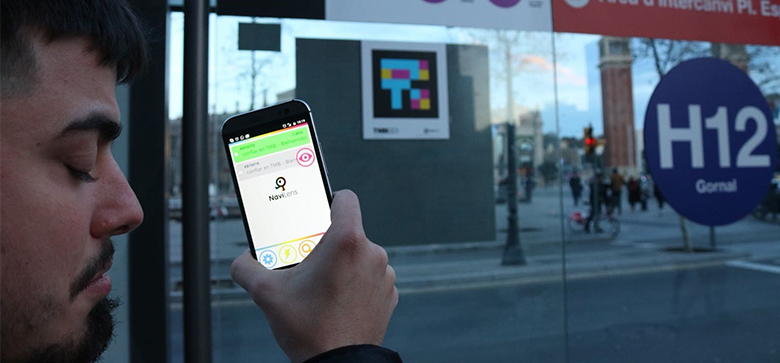Pedro Esquiva has been registered blind for 15 years. He used to struggle to get around Barcelona when he visited the city and was unable to properly use public transport without assistance. But now, with the help of mobile network technology his smartphone is acting as a second pair of eyes helping him and Ulises his guide dog to get around the city.

Pedro Esquiva, makes his way by bus in Barcelona
Navilens, created by Spanish companies Neosistec and MVRLab, helps people with visual disabilities to improve their ability to get around independently when in unfamiliar places.
The Vodafone Spain Foundation, which is eager to make technology a tool to improve people’s lives, has given NaviLens one of its annual Innovation Awards – created to promote and develop accessible ICT innovation projects to make the lives of vulnerable groups easier.We also displayed Navilens on the Vodafone stand at Mobile World Congress to help promote the technology and it captured the interest of, among others, the King of Spain.
Navilens’ technology is based on a new type of barcode called ddtags. Unlike the BIDI or QR codes, a 20 centimetre ddtag can be accurately read at a distance of up to 12 metres in just 0.03 seconds with a mobile device, while someone is moving and without the need to focus the phone’s camera. So just as a sighted person would move their eyes around an unfamiliar place looking for signage, a visually impaired person can do the same using their smartphone. As such it is more practical for use by the visually impaired than the alternative QR or Bidi codes.

Fira Metro Station L9 Barcelona
The technology is being tested in Metro Line L9 and Bus Line H12 of the Metropolitan Transport of Barcelona’s underground and train stations, so users with visual disabilities can more easily access public transport to get around the city.
NaviLens has also attracted the attention of multiple other companies and public administrations and could be used in the future everywhere from hotels to museums, hospitals, airports, education centers and shopping malls.
That would also mean that Navilens will enable visually impaired people like Pedro to access more services, faster and more easily than ever before.
Mari Satur Torre is Director of the Innovation Unit at the Vodafone Spain Foundation and is responsible for coordinating and managing several European and Spanish innovation and R&D projects. She is a senior telecoms engineer and holds a degree from the Polytechnic University of Madrid.

The Vodafone Spain Foundation is a not-for-profit charitable organisation that is functionally separate from Vodafone Spain. Under the vision of, “Connecting for Good: Connecting for Accessibility” it develops several projects and programmes with the purpose of helping people with disabilities and older adults to access the digital transformation of societies so that they can achieve full inclusion and participation.























